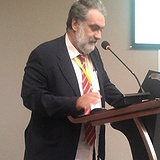Entropy, Nonlinear Dynamics, and Methods of Complex Systems in Earthquake Physics including Precursory Phenomena II
A special issue of Entropy (ISSN 1099-4300). This special issue belongs to the section "Complexity".
Deadline for manuscript submissions: closed (31 March 2021) | Viewed by 39076
Special Issue Editor
Interests: earthquake precursory phenomena; physics of earthquakes; earthquake prediction; natural time analysis; thermodynamics of point defects; complex systems physics; nonlinear dynamics
Special Issues, Collections and Topics in MDPI journals
Special Issue Information
Dear Colleagues,
During the last decade, considerable progress has been made towards the understanding of preseismic processes. In this direction, the physics of critical phenomena, information entropy, and methods of complex systems have been applied for the study of rupture in the solid Earth crust.
From another point of view, during the 21st century, many very strong earthquakes have taken place (e.g., the 2011 M9.1 Tohoku, the 2004 M9.0 Sumatra, Andaman, or the 2010 M8.8 Chile earthquakes). Since the instrumentation in our days is much better than that of the previous century, the study of various physical (or geophysical) observables before these earthquakes may provide useful precursory signals. When combined with and studied within the aforementioned frame of modern methods, such signals may lead to more efficient earthquake prediction methods than ever before.
The scope of this Special Issue is to strengthen and present the most recent attempts in both theoretical and experimental methods to understand the physics of earthquakes and, hence, foresee their occurrence.
Prof. Dr. Nicholas V Sarlis
Guest Editor
Manuscript Submission Information
Manuscripts should be submitted online at www.mdpi.com by registering and logging in to this website. Once you are registered, click here to go to the submission form. Manuscripts can be submitted until the deadline. All submissions that pass pre-check are peer-reviewed. Accepted papers will be published continuously in the journal (as soon as accepted) and will be listed together on the special issue website. Research articles, review articles as well as short communications are invited. For planned papers, a title and short abstract (about 100 words) can be sent to the Editorial Office for announcement on this website.
Submitted manuscripts should not have been published previously, nor be under consideration for publication elsewhere (except conference proceedings papers). All manuscripts are thoroughly refereed through a single-blind peer-review process. A guide for authors and other relevant information for submission of manuscripts is available on the Instructions for Authors page. Entropy is an international peer-reviewed open access monthly journal published by MDPI.
Please visit the Instructions for Authors page before submitting a manuscript. The Article Processing Charge (APC) for publication in this open access journal is 2600 CHF (Swiss Francs). Submitted papers should be well formatted and use good English. Authors may use MDPI's English editing service prior to publication or during author revisions.
Keywords
- Earthquakes
- Rupture
- Seismicity
- Entropy
- Nonlinear dynamics
- Complex systems
- Time series analysis
- Natural time analysis
- Electromagnetic phenomena
- Earthquake prediction
- Earthquake forecasting
- Applications






